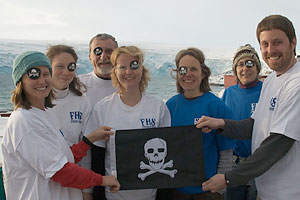

 | |||||||||||
|
|
Journals 2008/2009Megan O'Neill
May 1, 2009 First of May and it is a nice -3°C outside today! Kicked off the month with fish dissections. Irina tried to convince us of the German Holiday on this day and that she could not work! Her plan for observance of the International Labor Day did not work, so she got her solutions ready for the fish dissections. We are using the N. coriiceps species that are kept in the aquaculture tanks on the deck outside that are approximately 600 gallons in size. The tissues collected were heart, brain and pectoral muscle (very large!). I am the recorder for the first two dissections and the fish used were approximately 5.5 pounds and 53cm in length. These are the red-blooded species and have beautiful scales that are dark green to black and lighter on the abdomen. After collecting the needed tissue on the second dissection, Jeff continued with the dissection and we probed the stomach contents because the caeca were very large. Kelp and small krill made up the majority of the contents of the stomach. Both specimens were also female and were carrying eggs. Kristin, Jeff, Lisa and Irina worked on obtaining the mitochondria from the heart for observation. Seeing them in action, mixing up the solutions, centrifuging the tissue down to retrieve the mitochondria is fascinating! Meanwhile, Jody and Bruce are working on calibrating the tank heaters for the temperature tolerance tests. Bruce has designed this incredible system with an air mixer in the center of the tanks to distribute the water for consistent temperature throughout the tanks and inline flow meters with titanium heaters. They also corrected some problems with the holding tanks this morning, as the temperatures were at 1.8°C, which was much too warm for the fish and they had to switch to unfiltered seawater to try to lower the temperatures. Problem solving is absolutely vital in every stage of the experiments and this team is working together coming up with answers at every bump in the road. Seeing science in action is so great. Speaking of technology and science – not only am I able to connect to the Internet from Palmer Station and keep up with the world and receive e-mail and make phone calls home, but today I received an email from a student from Spain! When I was in the Arctic two years ago studying oceanography on a Spanish Naval Vessel, HMS Hesperides, a high school teacher from Spain, Catalina Sureda, was also with me as part of the education outreach (see my journals on www.armadaproject.org). When I contacted her about my experience in Antarctica, she emailed that one of her students is very interested in Antarctica and he emailed me to share photos and information with him! Just incredible, what a connection! I am thrilled to be part of such a network of information, and it is an example of how global today’s world really is!
|
||||||||||

